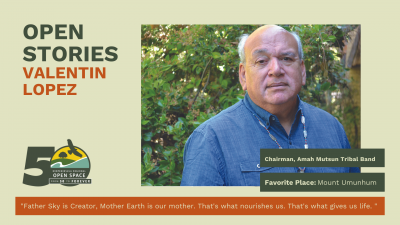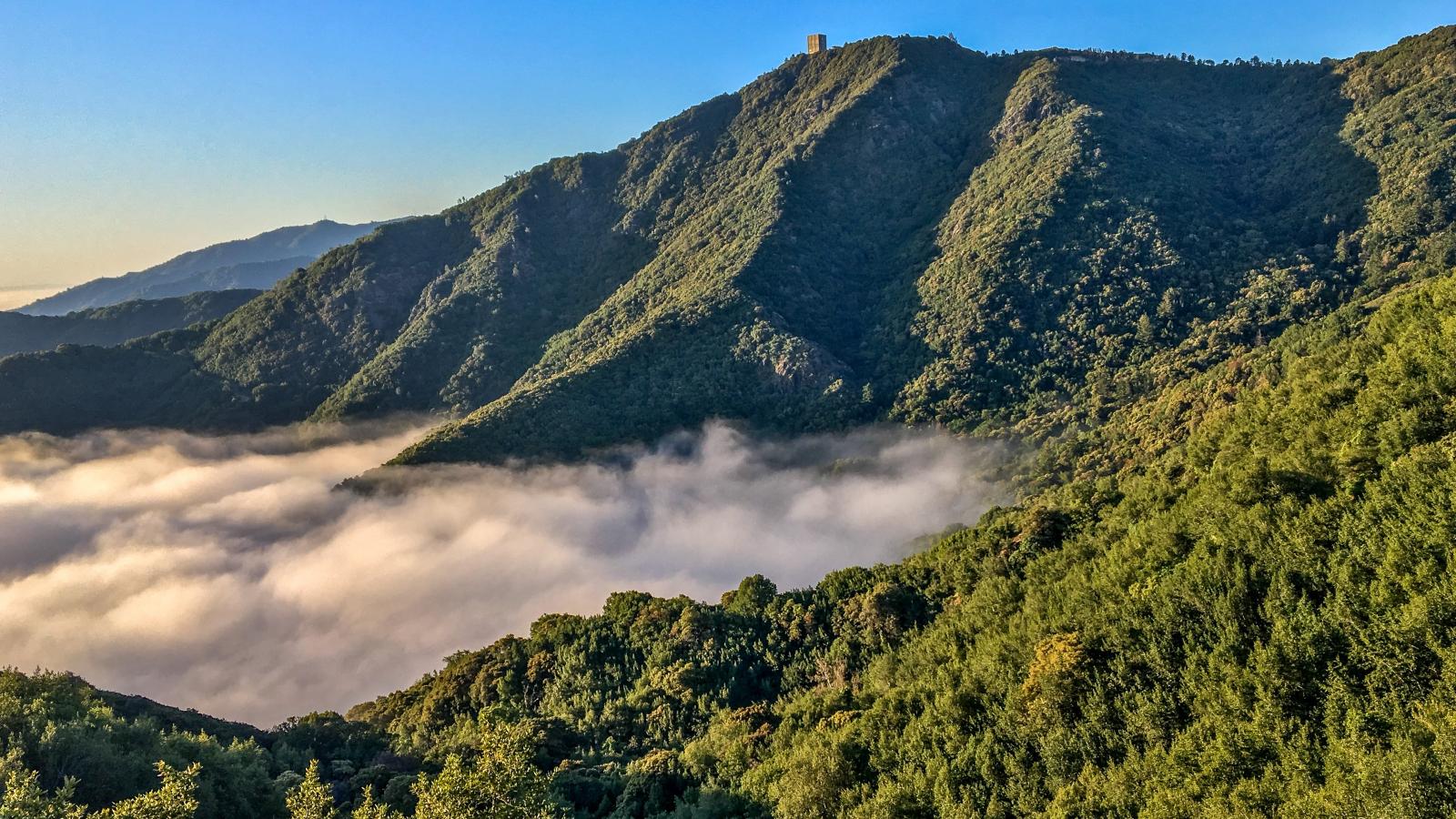
In honor of our 50th Anniversary, and to help tell the story of 50 years of open space protection, restoration and enjoyment, we are delighted to bring you this series we’re calling Open Stories, a collection of conversations about the many ways to connect with nature and your public open space.
“Our relationship with Midpen is pretty unique and pretty fortuitous for the tribe,” Valentin Lopez, elected chairman of the Amah Mutsun Tribal Band, an important and valued partner of the Midpeninsula Regional Open Space District, said.
“In 2006, the tribal elders came and told us we needed to get back to fulfilling the directives from our creation story, which tell us to take care of Mother Earth and all living things,” Lopez continued. “We didn’t know how we were going to do that because whenever we would look at the lands, we’d see ‘private property,’ ‘keep out,’ ‘no trespassing.’ So, we did what we always do, we prayed. We prayed as a tribe, asking Creator to help us find a way back.”
This historic and continuous, yet federally unrecognized, tribe consists of more than 600 people of indigenous descent who can trace their lineage to the traditional tribal territory known as Popeloutchom, which encompassed all or portions of modern Santa Clara, San Mateo, Santa Cruz, Monterey and San Benito counties, including the sacred Mount Umunhum, the crown jewel of land now protected as Sierra Azul Open Space Preserve.
“Our relationship with Midpen started whenever they were going to start working at Mt. Umunhum to do the restoration up there,” Lopez said. “They contacted us and recognized us as an important stakeholder at Mt. Umunhum, because Mt. Umunhum is where our creation story takes place.”
For the Mutsun, everything begins on the mountain. The Creator, working through eagle, hawk, hummingbird and other ancestral relatives, created all life — plants, wildlife, people, as well as wind and fog. Everything that is or can be known, came to be on that mountain top. Mt. Umunhum, which, in the Mutsun language, means home or place of the humunya (hummingbird), is so named because hummingbird carried an ember in its long beak, bringing fire up the mountain to the ancestors. When the ember flamed, hummingbird was marked with a ruby red throat.
Lopez was surprised when Midpen came calling, asking the Amah Mutsun what they wanted to see happen at Mt. Umunhum. “Nobody had ever reached out to us as Midpen had,” Lopez said. “And, lo and behold, Midpen took our requests very seriously and worked hard to help us bring our desires and our visions to pass.
“We look at all of the things that we see,” Lopez said, calling out trees, grasses, clouds, flowers. “They're all relatives. They have the same mother and the same father as we do. Father Sky is Creator, Mother Earth is our mother. That's what nourishes us. That's what gives us life. That's what brought us here. They are our relatives, and we have a relationship with them that is very loving, that is very caring and gentle.”
The Amah Mutsun Tribal Council asked for Mt. Umunhum to be restored as a sacred place, not only for them, but for all people, and worked with Midpen to create a ceremonial circle and to restore native plantings on the summit. The 60-foot circle is marked by a low rock wall, built by hand from stones quarried nearby, and is intended as an elemental, functional and enduring place for dance, prayer and gatherings for anyone who wants to find their own meaningful experience and connection to nature and the mountain.
“To our people, two things give a person wealth,” Lopez explained. “The first thing is, you know, carrying down the knowledge learned from our ancestors, generation to generation. How much of that knowledge do you carry? Do you know our ceremonies? Do you know our places of power? Do you understand, you know, how to fulfill your obligation the creator to take care of Mother Earth?
“And then the second thing is, are relationships. What kind of a relationship do they have with Mother Earth? Do they know how to take care of the plants so that they provide for our other relatives, the four-legged, the winged, the finned, etc.? Do we know how to take care of all of those? Those are all relationships and, so, restoring the relationship with the Mother Earth, the land, the mountain and the spirituality that’s there. Those are the things that are absolutely so important to us.”
While many people may have rediscovered their connection to nature during the pandemic over the past two years, Lopez said the Amah Mutsun have not had the same opportunity.
“We are a poor tribe,” he said, “and because of that our people do not live within our tribal territory. So, it’s not as easy for them to come on over to the Coast to be on the land or to be on Mt. Umunhum. Our tribe has been very impacted by COVID. We have not had tribal gatherings for that reason.”
Lopez describes a cultural awakening to equity and inclusion issues through land acknowledgements and interest in indigenous languages and land management practices as vital to the Amah Mutsun, and to nonnative people.
“Our people were given the responsibility to care of Mother Earth and all livings things, and that was a responsibility they took very seriously,” he said, adding that the tribe is working hard with universities, researchers and other land managers to bring back native stewardship practices like using prescribed burns to keep fuel loads from building up and resulting in catastrophic fires. “They understand the importance of Native American indigenous land stewardship. They know that we have to bring that back. Today, people really do want to and need to learn about it, you know, about how to restore the land and to have a relationship with those lands.”
Lopez said that much of that indigenous knowledge was lost due to the brutal history of the tribe, including three periods of colonization that reduced the population by more than 98%.
“In our culture, when the elders ask you to do something, it’s a directive, not a polite ‘why don’t you give this some consideration and see what you come up with.’ It’s a ‘you will do that,’” he said, smiling, then softening. “We have to recognize what happened to us is not our fault. But we also have to recognize that we have a responsibility to relearn that knowledge and to continue on that journey of our ancestors of taking care of Mother Earth.”
Today, the Amah Mutsun continue that journey through their Amah Mutsun Land Trust (AMLT), which partners with agencies like Midpen to gain access to more than 140,000 acres within their traditional territory.
Lopez says the AMLT has four goals: to protect and conserve their cultural and sacred sites; to do research to restore the indigenous knowledge that was lost as a result of their history; to educate tribal members and the public, including by telling the truth about their history; and to build an active Amah Mutsun stewardship corps to come back and restore the lands.
“This past summer we worked with Midpen at the base of Mt. Umunhum on land restoration efforts there and we’re very grateful for that opportunity,” Lopez said.
The staff at Midpen are also grateful to share this journey with the Amah Mutsun. We’re appreciative of their partnership and collaboration as we work to build a community that understands and values the interconnectedness of all things and the richness that healthy nature can bring to our lives.
To learn more about the Amah Mutsun Land Trust, please visit amahmutsunlandtrust.org. And, join us as we commemorate Midpen’s 50th Anniversary in 2022 by celebrating the people and partnerships who have brought us to where we are today.

